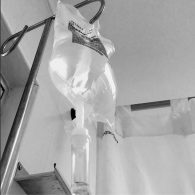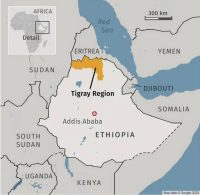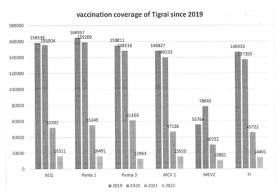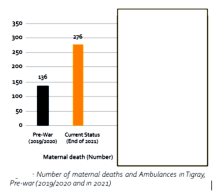
The Tigray, Ethiopia case of PHM online gallery focuses on the health worker crisis as a consequence of the war in the Tigray region. Despite the gravity of the situation, this is a conflict that has received little attention in the mainstream. The impact on health workers aggravates the already grave humanitarian crisis, as the repression against health workers, in all its forms, has an enormous impact on the quality and the number of health services provided today. Through the individual case of ‘X’ below, we try to bring the focus on the impact and issues faced by the health workers in the Tigray region.
This case, as do all the others in the online gallery, focuses on the repression against health workers and its impact on the right to health in the besieged region of Tigray. PHM understands that the historical political context leading up to the current crisis is very much part of a larger debate, but at the same time is very clear the severe impact on the right to health in the Tigray region must be denounced.
Healthcare in war-torn Tigray: targeted or collaterally attacked?
- Who is ‘X’?
Because of security reasons the name of the healthcare worker facing repression in the Tigray region can not be shared. She is 33 years old, a medical doctor working in Ayder Hospital, currently in the department of internal medicine. “Healthcare workers in Mekele (capital Tigray) face a constant threat, we have to work amidst heavy shelling, and dozens of healthcare workers have died. In our hospital we are obliged to use expired medicine and supplies and even have to advise patients to go home for the lack of available basic medication.”
Health facilities in the region are under constant attack of unmanned drones and without basic medical supplies. However, the attacks in the conflict were not limited to the health facilities but have also brutally targeted the health personnel as well. Health care workers in Tigray were killed, displaced, and lost their job or are working in an extremely stressful environment. Tigray Regional Health Bureau has reported the death of 37 HCWs health workers (1), the UN reported the death of 23 aid workers (2), and MSF confirmed that three healthcare workers were killed by Ethiopian Federal forces (3). Health care workers also lost their jobs; only 50% of the total of 25,000 health workers reported on their duty in April 2021 (4) and this number, not surprisingly, reduced to only 1,300 in May 2022 (5). None of the health workers received their salary since May 2021 nor they accessed their savings, as the banking service is not operating throughout the region.

- What happened?
Since November 4, 2020, the Tigray regional state, Northern Ethiopia, is at war with the allied forces of Ethiopian National Defense Forces (ENDF), Amhara non-state armed groups, and Eritrean troops. The forces fighting on behalf of the Tigray Regional Government are called Tigray Defense Forces (TDF). Serious abuses that may amount to war crimes have been carried out by forces on both sides.
“Nowhere in the world are we witnessing hell as in Tigray. The situation is desperate. It is so dreadful and unimaginable that a government is denying its own people for more than a year food and medicine and the rest to survive. This has to stop,” WHO Director General Dr. Tedros Ghebreyesus said. (-> https://twitter.com/ungeneva/status/1481634552711987204 )
Ethiopian forces and their allies have frequently violated the laws of war. They destroyed and targeted homes and civilian infrastructure while shutting off basic services and severely obstructing aid to civilians caught up in the fighting. The Ethiopian authorities imposed an effective siege on the entire region, keeping out virtually all humanitarian assistance for civilians in violation of Ethiopian domestic law, international human rights, and humanitarian law (6). Tigrayan forces were accused of very serious abuses like summary executions, sexual violence, and attacks on civilian structures such as healthcare facilities, in the Amhara and Afar regions after conflict spread there in July 2021. According to a 2021 report by a Joint Investigation by the Ethiopian Human Rights Commission (EHRC) and the Office of the United Nations High Commissioner for Human Rights (OHCHR) there are reasonable grounds to believe that all parties to the conflict have made use of civilian infrastructure, including health centers, for military means and have attacked civilian objects enjoying special protection under international humanitarian law, including hospitals and health centres.
Two years since the start of the war, Tigray has no access to internet, electricity, banking services, and transportation into and out of the region. Furthermore, access to fuel, medicine, food aid, and other basic humanitarian needs is scarce in the region. Despite the humanitarian ceasefire declared by the government on March 24, 2022, too little humanitarian aid is getting in. Mobility is also reduced to almost zero. Health workers did not receive their salaries since May 2021. The siege has prevented people from getting healthcare, food, and other basic services, and stymied the recovery of a health system broken by the conflict. For months, federal and regional forces blocked off the roads, making it nearly impossible for private actors or humanitarian agencies to carry in medical supplies or food. Supplies decreased to alarming levels (7).
Nevertheless, the Tigray crisis is very much a crisis that gets little or no attention at all despite its dire humanitarian situation, and the volatile nature of the conflict where it already starts to destabilize the entire horn of Africa.
- How does the war in Tigray impact the right to health of the people?
The Tigray Regional Health Bureau reported that 78% of health posts, 72% of health centers, and 80% of hospitals have been destroyed as of February 2022. The systemic attacks on health care workers in the Tigray, together with the damage to the medical infrastructure and extreme lack of medical supplies, has all led to the complete collapse of the healthcare system.
This all had a disastrous impact on the right to health for the local people i.e. health outcomes of the population. For example, antenatal care reduced from 94% to 16%, facility based delivery reduced from 81% to 21%; full vaccination rate reduced from 73% to 27%, and acute malnutrition increased from 32% to 78%. Moreover, the regular follow up of people with chronic conditions is highly interrupted, if not, stopped. The consequences are alarming;, the recorded death of 1,598 diabetes and 2,385 hypertension patients.


- The campaign for the protection of the health workforce in Tigray
The Tigray PHM online gallery-case focuses, more than other cases, on the general health worker crisis and the impact on them as a consequence of the war. This aggravates the already grave humanitarian crisis since, the repression against health workers, in all its forms, has an enormous impact on the quality and the number of health services provided today. The goals of the campaign are:
- Enhance visibility: the Tigray war, and more specifically the repression on health workers and the complete collapse of the healthcare system, remains very much a hidden conflict, explaining the (international) insufficient willingness to work towards a solution.
- Document the conflict and its impact on the health workers especially through the PHM network in the ESA region.
- Campaign on the vital demands; (a) access to humanitarian aid incl. medicines must be ensured. For the moment there is no humanitarian aid entering the region. The UN, WHO, African Union, ICRC must pressure national and local authorities to allow humanitarian aid into the region. (b) The protection of healthcare workers, and the respect for decent working conditions, incl. salaries, must be ensured.
PHM works towards these campaign goals implementing following activities:
- Webinar on November 2, 2022, on the second anniversary of the war.
Healthcare in war-torn Tigray: targeted or collaterally attacked?/ Nov 2 ’22, 12 pm UTC
ZOOM link to register: https://us06web.zoom.us/webinar/register/WN_f-3Ewm9RRHKHq4xguk-dtw
- A video was developed with testimonies from health workers and patients in Tigray.
Call to action:
- Reach out to us so we can keep you posted on future actions and plans -> david@vivasalud.be
- Join the task force working on this case! Currently it consists of health practitioners in and outside Tigray, academics, and activists.
- Share our activities (webinar on NOV 2).
References
- Godefay H. Opinion: In Tigray, we are demanding food and medicine, not bombs. 2022. https://www.devex.com/news/opinion-in-tigray-we-are-demanding-food-and-medicine-not-bombs-102621 (accessed 19 July 2022).
- OCHA. HC a.i. statement on the killing of 23 aid workers in the Tigray region since the start of the crisis. 2021. https://reliefweb.int/report/ethiopia/hc-ai-statement-killing-23-aid-workers-tigray-region-start-crisis (accessed 19 July 2022).
- MSF. Ethiopia: MSF seeks answers from government after new media report on killing of its staff. 2022. https://www.msf.org/ethiopia-msf-seeks-answers-government-after-new-media-report-killing-its-staff (accessed 19 July 2022).
- Gesesew H, Berhane K, Siraj ES, et al. The impact of war on the health system of the Tigray region in Ethiopia: an assessment. BMJ Global Health 2021; 6(11): e007328.
- Gebregziabher M, Amdeselassie F, Esayas R, et al. Geographical distribution of the health crisis of war in the Tigray region of Ethiopia. BMJ Global Health 2022; 7(4): e008475.
- https://www.hrw.org/news/2022/08/31/confronting-ethiopias-abusive-siege
- https://www.hrw.org/news/2022/08/31/confronting-ethiopias-abusive-siege
- 1. https://www.hrw.org/news/2022/09/27/q-renewal-mandate-international-commission-human-rights-experts-ethiopia-ichree; 2. https://www.ohchr.org/sites/default/files/2021-11/OHCHR-EHRC-Tigray-Report.pdf; 3 https://www.thenewhumanitarian.org/news-feature/2022/04/26/tigrays-health-system-collapsed; 4 Burki T. Humanitarian crisis in Tigray amidst civil war; 5 The Lancet Infectious diseases 2022; 22(6): 774-5; 6 Godefay H. Data shows siege and destruction of health system are causing preventable deaths in Tigray. 2022. https://www.ethiopia-insight.com/2022/01/26/data-shows-siege-and-destruction-of-health-system-are-causing-preventable-deaths-in-tigray/
- TRHB. Tigray health sector. Annual Bulletin 2021. Mekelle, Tigray: Tigray Regional Health Bureau, 2021.
